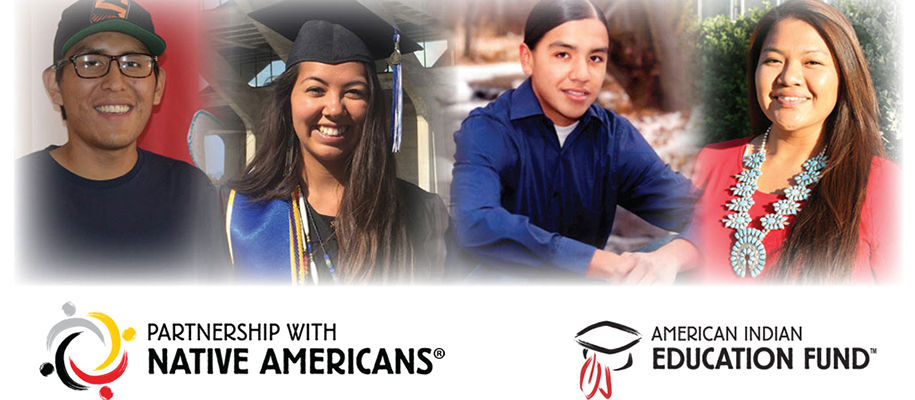Accessing education is a struggle for many students and families across the country. For Native American students in particular, the barriers start at an early age. According to Partnership With Native Americans (PWNA)—a nonprofit organization whose vision is to create “strong, self-sufficient Native American communities"—one-third of Native American children live in poverty, and many have to travel for hours each day across rugged, remote areas to attend school. Many lack simple tools such as notebooks and pencils needed to participate in class.
As these students grow older, many think college isn’t an option for them, especially as they struggle to find funding—because despite the common belief, Native Americans don’t attend college for free. “Today, only 17% of Native American high school graduates begin college,” reports PWNA, “and of these [students], only one in five makes it through the academic, emotional, and financial stresses of the first year.” What can students, families, and colleges do to change this? What resources are available for Native students to help them succeed in school, pay for college, and make their higher education dreams a reality? We asked PWNA's Programs team these questions and many more; check out their invaluable advice below.
Starting the college search
CX: What advice would you give to Native American students who want to attend college but may be pursuing it without the best educational foundation?
PWNA: Never give up on pursuing your dream of a college education. Many students face challenges like this, including Native American students. Our American Indian Education Fund (AIEF) scholarship committee has found that high GPAs don’t necessarily translate to college success. AIEF has witnessed many motivated students with mid-range GPA scores find success in post-secondary work, and for this reason, AIEF prioritizes scholarship applications in the middle academic range. Motivation and perseverance are at least half of the battle, and many of the AIEF scholars are also driven by their desire to create positive change in their own communities.
Related: Start your higher education journey with our Ultimate Guide to the College Search
Obstacles in the college search and application process
CX: What’s the biggest hurdle you feel Indigenous and Native students face in the college search and application process? What advice would you give to help them overcome that hurdle?
PWNA: Many Native American students hesitate when applying to college, primarily due to a lack of college funding and not wanting to incur debt with student loans. Many Americans believe college is free for Native Americans, but, in reality, only a few colleges offer tuition waivers for Native students, and this is sometimes limited to students in their state. Many tribes also have limited funding for college, and Native students apply for grants and compete for scholarship funding just like other students across America.
Through our AIEF program, we’re seeing more and more Native students applying for undergraduate and graduate schools—many of them are the first in their families to attend college. There’s hope for every student. Native American students who are truly motivated to attend college should start working with their high school counselor as early as possible, even by grade 10 or 11. Ask them about available scholarships, how to apply for federal scholarships (the FAFSA), how and when to take the ACT or SAT exam, and what else you need to do to get ready for college.
Finding a school that fits
CX: What should Native students look for during their college search to ensure they attend a supportive and inclusive campus community?
PWNA: Tribal colleges and universities with an organized Native Student Services Center are a good bet. If possible, students should tour the school ahead of time (or at least explore the college online) to get a sense of what life on campus is like. Some colleges offer early orientation for incoming Native students to help them acclimate before the rest of the student body arrives. Students should also be mindful of all their options such as tribal colleges, regional community colleges, four-year universities, and trade/vocational schools. We recommend that Native students meet with their high school counselor about which type of school best fits with their educational goals.
Getting to college and staying enrolled
CX: What can colleges do to help shrink the college access gap for Native students, and how can they help ensure more of these students graduate in four years?
PWNA: Colleges can help address the funding gap by raising funds earmarked for Native students. Additionally, getting Native students connected to a school’s Native Student Services Center is a great aid, especially for first-year Native students who face unique barriers that other students don’t. For instance, some are living off reservation for the first time, are disconnected from their family, and often face social prejudice.
AIEF also offers a unique mentorship program that connects scholars to professionals in the workplace. We send them care packages at back-to-school and exam time, and we also remember them during the holidays with gifts for them, their siblings, and/or their children under age 10 to ease stress around exam time. The students really appreciate our support and connection throughout the school year. Some have even told us most scholarship providers send a check and are never heard from again.
Resources for Native American students
CX: What resources would you suggest for Native students regarding financial aid opportunities, college admission, and the college search?
PWNA: Native American students across the US can apply for American Indian Education Fund scholarships and learn more about our criteria here. For more information, you can also call 800-416-8102.
Related: Read more about Mental Health and Discrimination: Facts, Resources, and Advice for Students
It may feel like too many obstacles are in your way as a Native student, but let your passion and determination to gain a quality education drive you. By persevering, utilizing resources at your disposal, and reaching out to those who can assist you, you can make your college dreams come true. Happy Native American Heritage Month!
To learn more about Partnership With Native Americans’ mission and efforts to increase college access and retention for Native American students, please visit NativePartnership.org. You can also start your higher education journey right now on CollegeXpress—click here to research your options and connect with schools using our College Search tool!







